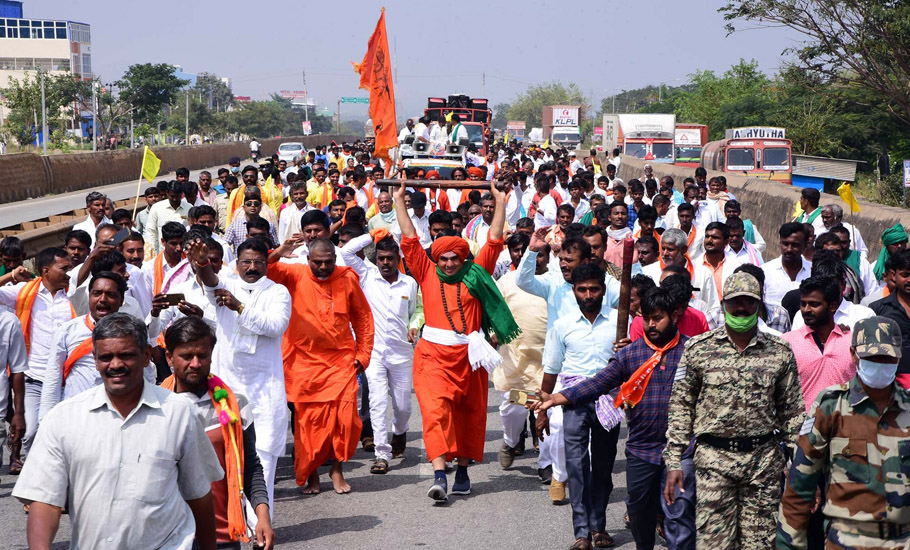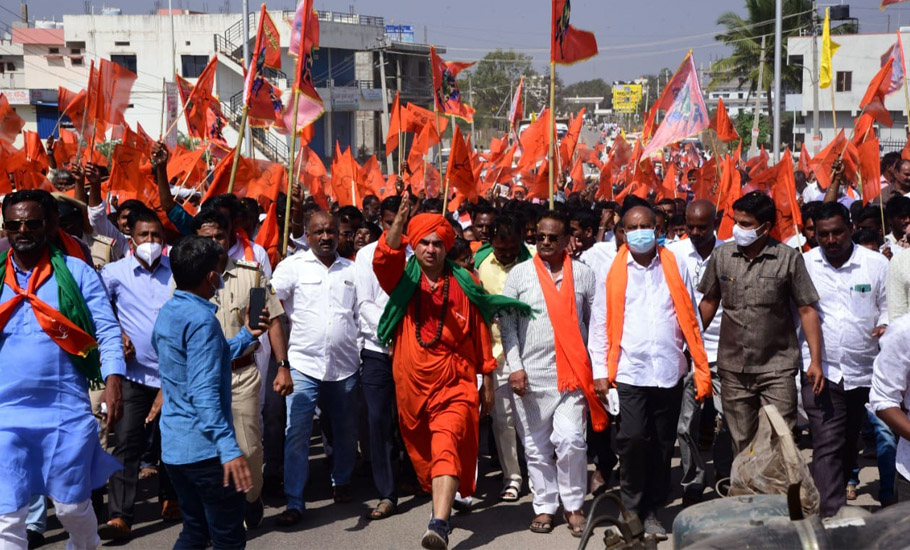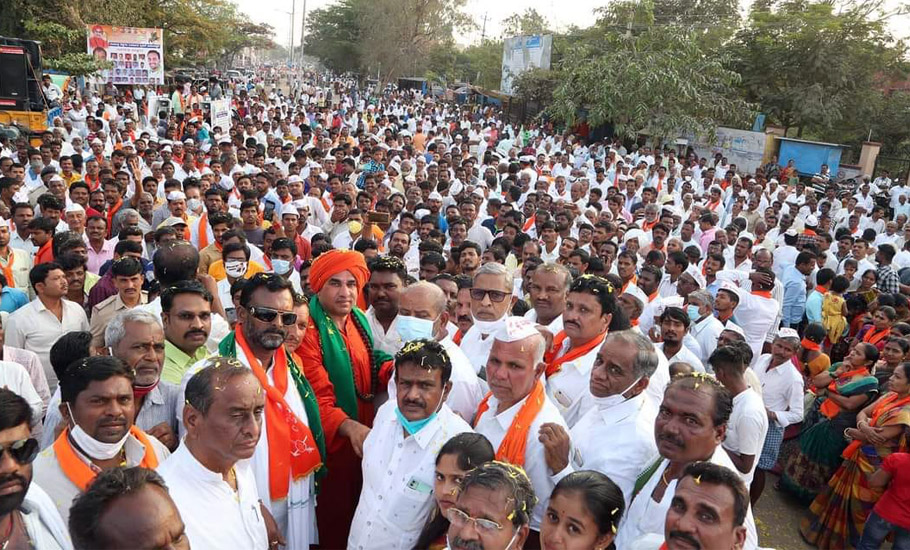
- Home
- News
- Analysis
- States
- Perspective
- Videos
- Education
- Entertainment
- Elections
- World Cup 2023
- Features
- Health
- Budget 2024-25
- Business
- Series
- NEET TANGLE
- Economy Series
- Earth Day
- Kashmir’s Frozen Turbulence
- India@75
- The legend of Ramjanmabhoomi
- Liberalisation@30
- How to tame a dragon
- Celebrating biodiversity
- Farm Matters
- 50 days of solitude
- Bringing Migrants Home
- Budget 2020
- Jharkhand Votes
- The Federal Investigates
- The Federal Impact
- Vanishing Sand
- Gandhi @ 150
- Andhra Today
- Field report
- Operation Gulmarg
- Pandemic @1 Mn in India
- The Federal Year-End
- The Zero Year
- Premium
- Science
- Brand studio
- Home
- NewsNews
- Analysis
- StatesStates
- PerspectivePerspective
- VideosVideos
- Entertainment
- ElectionsElections
- Sports
- Loading...
Sports - Features
- Budget 2024-25
- BusinessBusiness
- Premium
- Loading...
Premium

Karnataka’s reservation conundrum: Bending backward for forward castes

On January 14, Basava Jaya Mrutyunjaya Swami, the seer of the Lingayat Panchamasali Mutt in Kudala Sangama in Bagalkot district, started his 450-km padayatra (walkathon) demanding change in reservation categorisation for Panchamasali Lingayats within the state’s Other Backward Caste (OBC) list. The Panchamasalis, one of the largest sub-sects within the dominant Lingayat community, are...
On January 14, Basava Jaya Mrutyunjaya Swami, the seer of the Lingayat Panchamasali Mutt in Kudala Sangama in Bagalkot district, started his 450-km padayatra (walkathon) demanding change in reservation categorisation for Panchamasali Lingayats within the state’s Other Backward Caste (OBC) list.
The Panchamasalis, one of the largest sub-sects within the dominant Lingayat community, are demanding that they be moved from the 3B category of OBC, which assures 5% reservation, to the 2A category, which assures 15% reservation.
As a symbolic move, the seer started his journey from Kudala Sangama, the resting place of Basavanna, the founder of the Lingayat sect in the Hindu religion. The seer’s rally concluded in Bengaluru on Sunday (February 21), with a mass convention in Palace Grounds.
The seer, who enjoys significant political clout, with the backing of several Lingayat leaders in the state cabinet, threatened Chief Minister BS Yediyurappa, who hails from the same community, that he may lose the support of the community if their demand is not met. He also threatened to lay siege to the state Assembly from February 22 and go on an indefinite hunger strike to pressure the state government to meet his demands.
Stirring the hornet’s nest
At present, In Karnataka, the Scheduled Caste (SC) are allocated 15% reservation, Scheduled Tribes (ST) 3%, and the Other Backward Castes (OBC) 32%, totalling 50%, a limit capped by the Supreme Court. Within the OBC, there are five subcategories—category 1 (4%), category 2A (15%), category 2B (4%), category 3A (4%) and category 3B (5%).
Currently, Panchamasalis are in category 3B with 5 percent reservation and share it with other caste or religious groups such as Marathas, Jains, and Christians. They are now demanding to be included in category 2A with 102 other caste groups. This would bite into the share of smaller and marginalised caste groups such as Ediga, Billava, and other backward communities who are in the 2A category. They are now opposing the 2A reservation tag for Panchamasalis.
Mrutyunjaya Swami’s demands have also stirred the hornet’s nest. Other caste groups, who were already demanding equitable quota based on their population size, are now holding rallies to demand their share. Kurubas, Madigas, SCs, STs, Kunchatigas and others are demanding a revision in quota.
The Scheduled Castes are now demanding the state to revise their quota from 15 percent to 17 percent and the Scheduled Tribes from 3 percent to 7 percent, based on Justice HN Nagamohan Das Commission report.
“The SC/ST reservation quota was fixed many years ago. Now, with the change (increase) in population, there is pressure to revise it. A cabinet sub-committee will look into this,” former law minister (now minor irrigation) J C Madhuswamy had said in January.

Seer who can tilt the scales
Mrutyunjaya Swami, a prominent figure among the Lingayats who spearheaded the independent religious movement for Lingayats, said the Chief Minister owed a lot to the Panchamasali community, largely concentrated in North Karnataka, as they are the ones who helped him climb the political ladder.
He even appealed to legislators belonging to the community to pressure the CM or make him resign from the post and select a community leader from North Karnataka as the Chief Minister.
The pontiff now rallies behind Basangouda Ramangouda Patil Yatnal, a Yediyurappa critic within BJP. The seer had even objected to the Centre issuing a show-cause notice to Yatnal for speaking against the CM and his son over corruption issue.
The seer had in the past pressured the CM to include MLAs from the community (Murugesh Nirani and Umesh Katti) in the cabinet. As they both served as ministers in Yediyurappa’s cabinet during his previous regime in 2008 and were trusted lieutenants of the CM, they were inducted after a long ordeal during the reshuffle in January this year.
“The community with nearly 85 lakh people are largely farmers with a poor socio-economic background. There’s nothing wrong in including them under the 2A category,” the seer said.
CM’s dilemma
Chief Minister BS Yediyurappa belongs to the Banajiga sub-sect within the Lingayats.
If Yediyurappa accords 2A status to Panchamasalis, the CM would be antagonising other sub-sects. Hence, he is treading a cautious path.
Yediyurappa’s close aides think it’s a plan hatched to unsettle him as CM. In October his attempt to include Linagayats under the central OBC list (27% reservation) failed as the central leadership viewed it as a dangerous move which would have ramification on a national scale.
To temporarily satisfy the community, the CM had formed a Veerashiva-Lingayat Development Board last year with Rs 500 crore allocation. And a fortnight ago, the CM said he ordered the Karnataka Backward Classes Commission to assess the socio-economic condition of Panchamashali Lingayats and submit a report and then take a call on the quota changes.
Despite knowing that there are legal implications and Centre-state tussle, the seers are issuing a deadline to the CM to announce his decisions. In Karnataka, the mutts are perceived to be powerful as leaders do go mutt-hopping during elections to appease the community and have allocated funds accordingly.

Yediyurappa’s earlier decisions during his previous rule in 2008-2013 to empower these mutts are biting him back. Back then, the BJP doled out around Rs 400 crore to religious institutions for development works and other activities within and outside Karnataka.
The Lingayat community got the lion’s share of the government’s donations (Rs 157 crore, aggregating to around 40 percent of the total funds allocated). In certain cases, the allocated funds exceed 10 times the permissible amount, violating government guidelines issued in September 2010 that put a cap on such allocations.
Today, the same mutts and seers are holding him to the task.
Twist in the tale
Not often do we see politicians from opposing parties indulge in a bonhomie for a common cause. Legislators and party leaders cutting across party lines are demanding that the state government make the caste census report public.
Former Chief Minister Siddaramaiah’s government spent ₹160 crore in 2015 to conduct a caste census. But by the time the report was completed, Assembly elections for 2018 were scheduled and the report was put on the backburner.
The subsequent governments, neither acknowledged the report nor made it public.
The silence is fuelling rumours that the political class was tweaking the data to suit their agendas. A change in caste proportion would change the political dynamics of the state.
Uproar from other communities
A day after the Panchamasali seer started his walkathon, the seers of Kuruba community, the shepherd class, also started a similar padayatra to demand ST status while they are currently under 2A category of OBC.
Including them under STs would not only entail education and job reservation benefits but also reservations in political representation, with an opportunity to contest in reserved constituencies.
The pontiff of the Kanaka Guru Peetha of Kaginele Niranjanananda Puri Swami held a rally from Kaginele (Haveri) to Bengaluru covering 340 km in 24 days.
Even though the state government has said that an anthropological study would be done to consider them under ST, the seer said the community meets all the parameters to be tagged as STs and dismissed the need for any such study.
This is not the time to protest to ask ST reservation for Kuruba community. Let the State govt recommend based on Kulashastra Adyayana report. If the Centre rejects, then the protests can be held.
1/4#Delhi
— Siddaramaiah (@siddaramaiah) February 16, 2021
BJP minister KS Eshwarappa and former Congress CM Siddaramaiah belong to this community.
Although Siddaramaiah supported the move, he did not attend the rallies, fearing that his image as a leader of Ahinda (Alpasankyataru, Hindulidavaru, and Dalits—minorities, backward classes, and Dalits) would be hit at a time when he’s looking to be the CM candidate for the 2023 election, overshadowing current Congress state chief DK Shivakumar.
Siddaramaiah has alleged that the Kuruba quota rally was a conspiracy by the RSS and BJP to divide the community and weaken him as their mass leader.
“The BJP is in power both in the state and at the Centre. So why can’t they include the Kurbas to the ST list instead of trying to get political mileage out of the issue with protests?” he questioned. “Let Eshwarappa (BJP minister) convince his party and send a recommendation to the union government.”
Following the demand for quota revision from Lingayats and Kurubas, the powerful Vokkaligas too have upped their ante. Vokkaliga pontiffs Nirmalanandanatha Swami of the Adichunchunagiri Mutt and Nanjavadhuta Swami of the Gurugunda Brahmeshwara Mutt joined the chorus to demand higher reservation for their community members.
There are 115 subsects within Vokkaligas. Not all are included in the OBC category. At present, only a handful of Vokkaligas subsects come under 3A category, with 4% reservation benefit.
“Many have failed to get benefits, all sub-sects and those from urban and rural areas too should be classified as OBC,” Nirmalanandanatha had said.
The meeting opined that there was scope to increase reservation as done in Tamil Nadu where the reservation has been capped at 69 percent.https://t.co/FHjno1OZiT
— Star Of Mysore (@Star_Of_Mysore) February 19, 2021
What about marginalised classes
Even as these forward communities are vying for a bigger share in the reservation system, the Madigas, the oppressed class classified within the SCs, who have for long felt that their caste struggle never got their due, are now planning a similar padayatra starting March.
Madigas have long been fighting for equitable reservation rights since the 70s. Their struggle picked up steam in the late 90s. A 2005 report by the Justice Sadashiva Commission which looked into the internal reservation among the Scheduled Castes, recommended a 6% reservation for Madigas in government jobs. But the government never acted on it fearing a political fallout, as the report also suggested weeding out the Vaddar (Bhovi), Lambani (Banjara), Koracha, and Korama castes from the reservation list that were relatively well off.
Harijana Nagendra, a 37-year-old Madiga who has worked as a manual scavenger and is now engaged in cleaning sewage, says he could never get any reservation benefits but hopes that his two children could avail them if they are made easy. That way, they can get out of the socio-economic backwardness.
Having studied till 10th grade, a first in his family, Nagendra says the caste legacy forced them into waste picking and sewage cleaning jobs and couldn’t find any alternative.
Madiga community leader Ambanna Arolikar feels that the reservation demand from forward classes could unsettle the balance and would further marginalise those already oppressed.
“Reservation is not liberation, it’s just upliftment. We haven’t progressed in 70 years as we were denied our rights. The government should take note and improve our condition rather than weaken it further by succumbing to certain sections’ demand for higher reservation,” Arolikar says.

